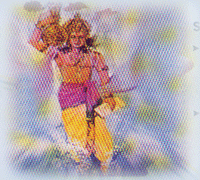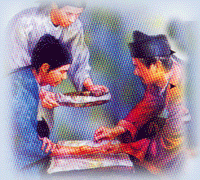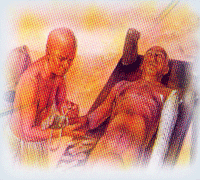|
COMPLEMENTARY THERAPIES FOR CANCER
Complementary Therapies are cost effective and improve
the confidence levels of the patients and their relatives
and enable them to fight the disease with a better frame
of mind. The motivation for seeking Complementary Treatment
more often appears to be fear and uncertainty rather
than belief in the efficacy of the treatment. For many
patients the use of Complementary Therapies represents
a means of dealing with the anxiety and stress surrounding
their disease. With the kind of positive results that
AMC Trust has been getting over the past few years,
the immediate need of the Trust is to embark upon a
major validation programme of combination therapies
carried out in a clinical fashion with internationally
approved protocols. Depending upon the type of cancer
and the patient's needs, the Trust would offer Complementary
therapy along with the conventional radio-/chemo therapies
or after the patient has gone through a complete course
of conventional treatment. One of the following Complementary
Therapies -Yogic therapy plus Homeopathy, Yogic Therapy
plus Ayurveda, Yogic Therapy plus Siddha, Yogic Therapy
plus Acupressure, will be offered to the patient. If
the patient cannot afford the cost of conventional treatments,
depending upon his / her faith and willingness to undergo
Complementary Therapies. Complementary Therapies treatment
can be offered immediately.
Do you know that the complementary therapies are
- Far less damaging
- Far less invasive
- Far more cost-effective
- Far more pleasant
- Far more manageable
- than conventional therapies?
- For better results, one should combine conventional therapies with complementary therapies. When a patient is too weak or cannot undergo chemo or radiotherapy, it is essential to choose one of the alternative therapies.
- Today the following alternative methods are used on cancer patients, but not yet well researched or validated. But there are known cases of cure. AMC Trust has had success stories with some of them.
 |
HOMEOPATHY
Homeopathy is derived from Greek words "Homoeos"
= Like or Similar; and "Pathos" = disease or suffering,
which means 'Likes cure Likes'. The efficacy of
homeopathy drugs is well established in almost all
the ailments including those which are a challenge
to the modern medicine such as Rheumatoid Arthritis,
Cancer (Malignancies of various origins), Diabetes
Mellitus, etc. Most importantly since homeopathic
medicines are in dilutions the side effects are
greatly minimized. Hence this system is perfect
in ailments of infants and children. |
| The effects or the medicinal values
of the drugs are determined by drug Proving. The
homeopathic drugs are derived from various sources.
A good remedy removes the disease from its roots
and leaves no trace of the disease behind. Individual
constitution is given prime importance in homeopathy
because no two individuals are alike. Hence we have
one drug per individual. This path thus becomes
unique and more accurate. Case taking is the most
vital part prior to treatment wherein the Doctors
analyze the mental symptoms along with the physical
symptoms. There is a concept of Vital force and
Miasmas that determine the health status of the
patient and his future health condition, which are
again unique to the principle of this path. |
| |
|
 |
AYURVEDA
Over the years scientists have been trying hard
to find a cure for cancer, which is incurable and
fatal unless detected in its early stage. Modern
researchers say cancer treatment will gradually
improve and perhaps in another 30 years we may have
something that works for several cancers. Since
cancer panacea is a long way off according to modern
scientists, it is high time we explore the remedies
described in other medical systems, especially yoga
and nutrition. |
Ayurveda describes that each person
has a physical and a mental constitution. In other
words everyone is born with a unique nature or a
unique personality. In order to maintain good health,
it is important to maintain this "original"
prakriti or nature. This is done by eating foods
and performing activities that are in harmony with
our nature. Thus a state of natural balance is maintained
at physical, psychological and spiritual levels.
However, a disturbance in the state of natural balance
leads to damages in the natural set of body even
at the minute level including the genes.
Ayurveda propounds the principle of natural living.
This includes food, environment, lifestyle, and
the like. Modern life often violates principles
of natural living. Artificial lights and air, processed
and preserved food items, polluted environment,
ingestion of chemicals in numerous ways, overworking
physically as well as mentally, imperfect relations
and negative emotions negate Ayurveda's principles
of natural living.
Ayurveda describes that in cancer, the blood becomes
impure due to aggravation of one or more dosha.
This impurity of the blood is actually related to
the subtle part of blood (rakta dhatu), and is not
detected by physical tests. The dosha may get aggravated
due to a number of factors including improper food
and lifestyle. Smoking, chewing tobacco, breathing
in chemical fumes or eating foods and fruits that
have been heavily processed with chemical during
cultivation also aggravate dosha in the body. Although
cancer is a difficult disease, Ayurveda can offer
a lot of support and comfort to the patients through
its natural treatments. |
| |
|
 |
ACUPRESSURE
This therapy involves pressing points on the body
with fingers or hands to alter the internal flow
of a supposed vital force or energy called chi (pronounced
"chee"), strengthening it, calming it and removing
a blockage of the flow. Acupressure is one of the
treatment methods regularly used in traditional
Chinese medicine, or TCM, a system of health care
that originated in China thousands of years ago
and is still widely practiced in Asian countries
today. |
| According to Traditional Chinese Medicine
acupressure points are aligned along 14 bodily meridians,
or pathways. Twelve of the meridians are bilateral;
that is, identical versions of them (with the same
sets of points) exist on both sides of the body.
The other two are unilateral, running along the
midline of the body. The 14 meridians do not correspond
to any known physiological processes or anatomical
structures in the body, such as nerves or blood
vessels. Nevertheless, some well-controlled studies
suggest that acupressure can be effective for a
number of health problems, including nausea, pain
and stroke-related weakness. A single point may
be pressed for relief from a particular symptom
or condition; or to promote overall well-being of
the body, a series of points can be worked on in
a specific order. Acupressure Points
Acupressure can be administered by someone trained
in the technique or it may be practiced at home.
The force used on different points varies, but
in general, most points call for a steady, downward
pressure lasting one to two minutes. If you are
applying pressure to a point several times in
succession, complete this process on one side
of the body before switching to the other side.
The risks of acupressure are minimal, provided
certain cautions are observed. During pregnancy,
the points designated Spleen 6 and Large Intestine
4 should never be used; avoid the abdominal area
entirely, if possible. Never apply pressure to
open wounds, varicose veins, tumors, inflamed
or infected skin, sites of recent surgery, or
areas where a broken bone is suspected. |
| |
|
 |
SIDDHA
Often considered as a branch of Ayurveda, Siddha
is an ancient Indian system of medicine, mainly
practiced in the state of Tamil Nadu in south India,
which is based on herbs and roots of plants. Many
plants, which are considered poisonous, are also
used in treating specific ailments. |
The Siddha system of medicine
may be classified into three parts:
- Herbal preparations
- Metal & mineral preparations
- Animal and other species preparations
Herbal processes are always recommended with
the other two parts. If there is any unwanted
material or any toxicity available with the other
two processes, herbal processes eradicate them
and act as the adjuvant drug to the major drug
and minimize the severity of the concerned disease
in a short period without any side effects. But
at the same time, diet restrictions are also instructed
according to the disease. |
| |
|
 |
UNANI
According to the principles and philosophy of Unani
Medicine, disease is a natural process, its symptoms
are the reactions of the body to the disease, and
the chief function of the physician is to aid the
natural forces of the body. Unani Medicine is basically
based on Humoral theory. |
According to Unani, cancer is essentially
a disease of the black bile humor. That is, it means
that all four of the humors are out of balance.
Ripening, purging, and rebalancing of each of the
four humors in turn are required for a cure to take
place. This is not an easy procedure, because the
superfluous and toxic by-products are constantly
being emitted, and since the last humor that is
out in the chain must usually be treated first.
This means that one must try to treat the black
bile humor first.
Cancer will be eliminated only when people return
to a more balanced, natural lifestyle, and keep
the body, mind, and spirit free from impurities. |
| |
| ACUPUNCTURE |
Acupuncture is a traditional Chinese
medical technique for manipulating chi (chi or qi)
in order to balance the opposing forces of yin and
yang. Chi, an alleged "energy" which permeates
all things, is believed to flow through the body
along 14 main pathways called meridians. When yin
and yang are in harmony, chi flows freely within
the body and a person is healthy. When a person
is sick, diseased, or injured it is believed that
there is an obstruction of chi along one of the
meridians. Acupuncture consists of inserting needles
through particular points on the body, allegedly
removing unhealthy obstructions of chi and thereby
restoring the distribution of yin and yang. Sometimes
the needles are twirled, heated, or even stimulated
with weak electrical current, ultrasound or certain
wavelengths of light. But no matter how it is done,
scientific research over the past twenty years has
failed to demonstrate that acupuncture is effective
against any disease.
A variation of traditional acupuncture is called
auriculotherapy or ear acupuncture. It is a method
of diagnosis and treatment based on the unsubstantiated
belief that the ear is the map of the bodily organs.
A problem with an organ such as the liver is to
be treated by sticking a needle into a certain point
on the ear which is supposed to be the corresponding
points for that organ. Similar notions about a part
of the body being an organ map are held by iridologists
(the iris is the map of the body) and reflexologists
(the foot is the map of the body). A variation of
auriculotherapy is staplepuncture, a method of treatment
which puts staples at key points on the ear hoping
to do such wonderful things as help people stop
smoking.
Acupuncture has been used in China for more than
4,000 years to alleviate pain and cure disease.
Traditional Chinese medicine is not based upon knowledge
of modern physiology, biochemistry, nutrition, anatomy
or any of the known mechanisms of healing. Nor is
it based on knowledge of cell chemistry, blood circulation,
nerve function, or the existence of hormones or
other biochemical substances. There is no correlation
between the meridians used in traditional Chinese
medicine and the actual layout of the organs and
nerves in the human body.
Despite lack of scientific support, acupuncture
is used in the treatment of depression, allergies,
asthma, arthritis, bladder and kidney problems,
constipation, diarrhea, colds, flu, bronchitis,
dizziness, smoking, fatigue, gynecologic disorders,
headaches, migraines, paralysis, high blood pressure,
PMS, sciatica, sexual dysfunction, stress, stroke,
tendonitis and vision problems. |
| |
| PRANIC HEALING |
| Pranic healing is an energy healing
technique based on the overall structure of the
human body. According to the precepts of pranic
healing, our body is actually composed of two parts:
the visible physical body, and the invisible energy
body called the bioplasmic body or aura. The visible
physical body is that part of the human body that
we see, touch, and are most acquainted with. Our
aura is that invisible luminous energy body, which
interpenetrates the visible physical body and extends
beyond it.
Pranic healing is an ancient science and art
of healing that utilizes prana (or chi/qi/ki)
or life energy and the chakras or energy centers
to heal diseased energy levels. The healing process
involves the manipulation of the patient's chakras,
ki and aura. It has also been called medical qigong
(ki kung or ki healing), psychic healing, vitalic
healing, therapeutic touch, laying of the hand,
magnetic healing, faith healing, and charismatic
healing.
Laws of Pranic Healing
Pranic healing is based on two laws: The law of
self-recovery and the law of prana or life energy.
It is through these basic laws that rapid or miraculous
healing occurs.
1. Law of Self-Recovery:
In general, the body is capable of healing itself
at a certain rate. If a person has a wound or
burn, the body will heal itself and recover within
a few days to a week. In other words, even if
you do not apply antibiotic on the wound or burn,
the body will repair or heal itself. At the present
moment, there is no medicine available for the
treatment of viral infection. But even if a person
has cough or cold due to viral infection, the
body will recover generally in one or two weeks
without medication.
2. Law of Life Energy:
For life to exist, the body must have prana, chi
or life energy. The healing process can be accelerated
by increasing life energy on the affected part(s)
and on the entire body.
Benefits of Complementary Therapies are:
1. Increasing life span (if certain tissues
have not been irreparably damaged by previous
medication).
2. Reduction in pain. Shifting of pain threshold
up. Reduction in usage of painkillers.
3. Reduction in ascites accumulation, which is
a severe nightmare in certain types of cancer.
4. Reversal of immunity suppression. Better health.
5. Return of body functions to normal.
6. Regression of cancer in some cases.
7. Sociability of patients and their interaction
with outside world improves.
8. Patient's dependence on others reduces.
9. Substantial reduction in the usage of Morphine.
|
| Reiki |
Reiki is a Japanese technique for stress reduction
and relaxation that also promotes healing. The
word Reiki is made of two Japanese words –
‘Rei’ which means "God's Wisdom
or the Higher Power" and ‘Ki’
which is "life force energy". So Reiki
is actually "spiritually guided life force
energy."
The treatment feels like a wonderful glowing radiance
that flows through and around you. Reiki treats
the whole person including body, emotions, mind
and spirit creating many beneficial effects that
include relaxation and feelings of peace, security
and wellbeing. Many have reported miraculous results
with Reiki. AMC Trust’s experience has been
good with Reiki as a pain control method and support
for patients suffering a lot.
Reiki is a simple, natural and safe method of
spiritual healing and self-improvement that every
one can use. It has been effective in helping
virtually every known illness and malady and always
creates a beneficial effect. It also works in
conjunction with all other medical or therapeutic
techniques to relieve side effects and promote
recovery.
The laying of hands is used in Reiki therapy also
as in spiritual healing. There is a difference
though. In spiritual healing, a person with a
strong energy field places his or her hands above
a particular part of the recipient's body in order
to release energy into it. So, here the healer
is the one who is sending out the energy. In Reiki,
however, the healer places the hands above the
recipient; however, it is the recipient that draws
the energy as needed. Thus, in this case, the
individual being healed takes an active part in
the healing process as opposed to having a passive
part in spiritual healing. The individual takes
responsibility for his or her own healing. The
recipient identifies own needs and caters to them
by drawing energy from the Reiki master as needed.
|
| |
| |
| |
| |
|